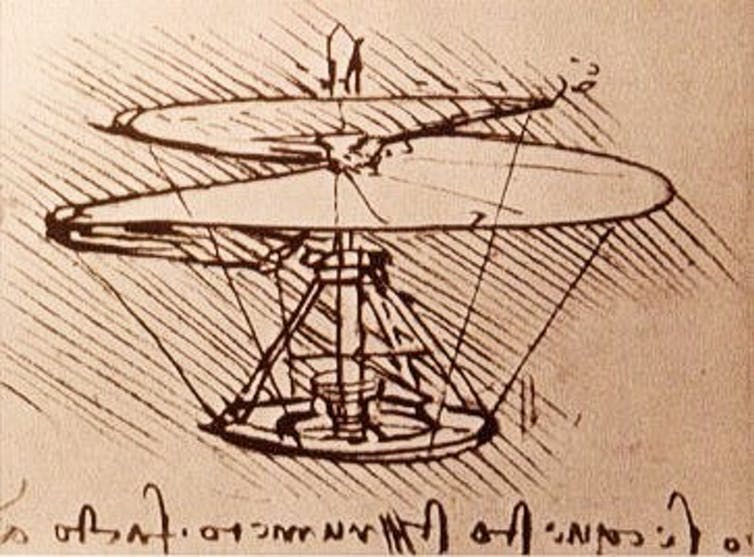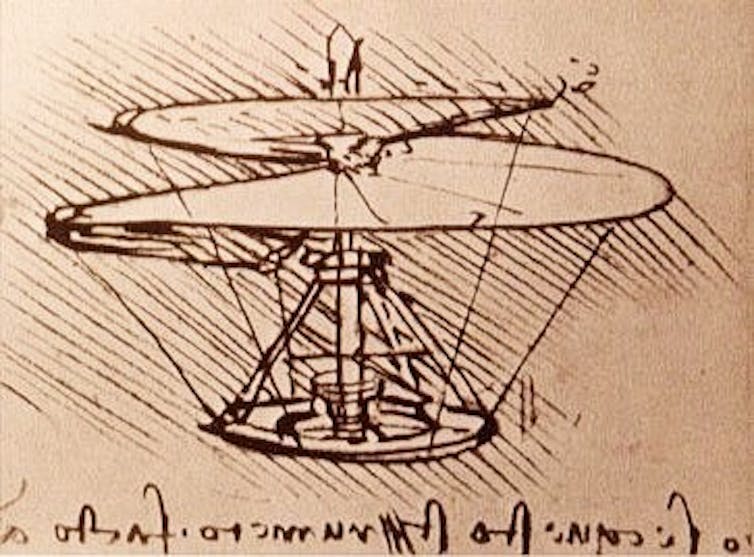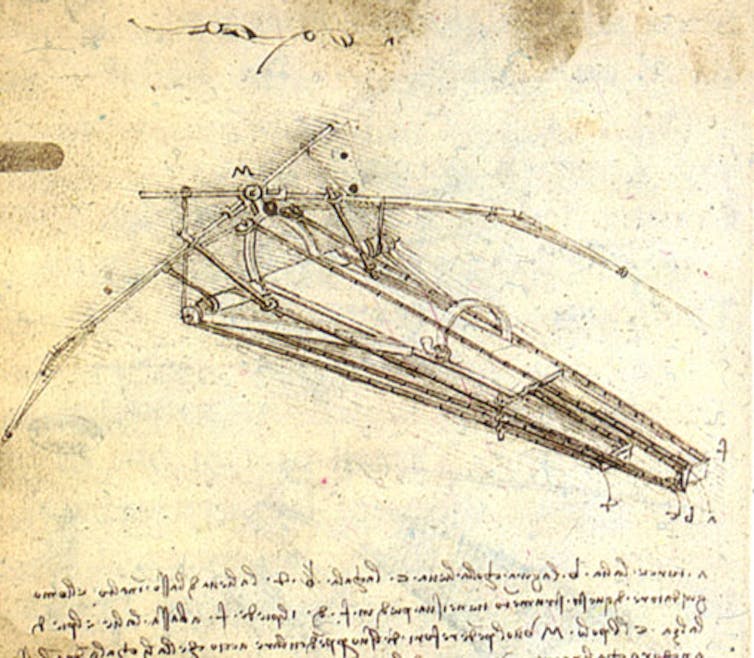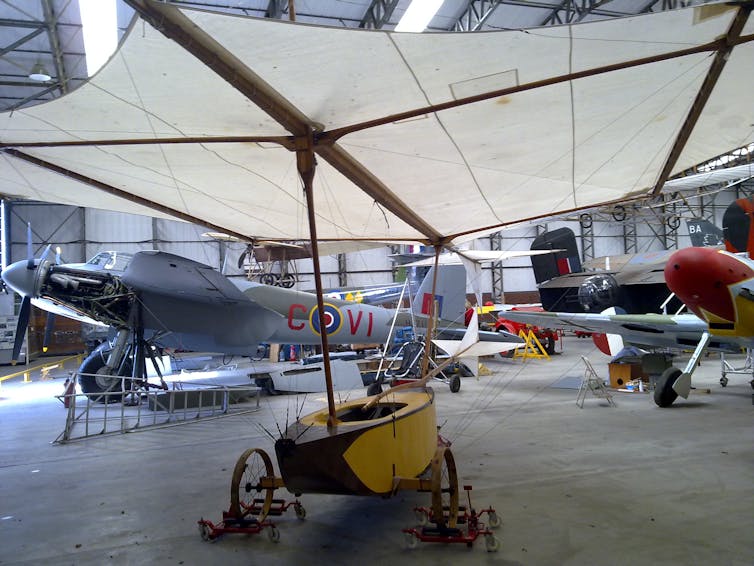Leonardo da Vinci’s helicopter: 15th-century flight of fancy led to modern aeronautics

Jonathan Ridley, Solent University
Humankind has always had a desire to fly. Flight may be normal for us now, thanks to the efforts of numerous engineers and scientists, but in the 15th century it existed only in myths such as Daedalus and Icarus – which wasn’t that encouraging, when you come to think of it.
One scientist and engineer at the time was fascinated by nature and blessed with a problem-solving mind able to combine the disciplines of art and science. He looked at flight from a different perspective and understood that it must be able to be described by mathematics. That, if understood correctly, could then be applied to make people fly. That scientist and engineer was Leonardo da Vinci.
Aside from his well-known exceptional breadth and depth of talent, Leonardo was notable in that he combined his knowledge across a range of disciplines in science with his imaginative problem-solving skills and applied it to design objects that were in some cases centuries ahead of his time.
These designs included sketches of designs such as a military tank, a parachute, underwater breathing equipment and a robotic knight. Few of these were built – or realistically, could be built in his time – but they offer a fascinating insight into science and engineering. In many cases, these designs were inspired by his observations of the natural world.

Leonardo seemed to have a particular interest in flying, with some of his work focused on measuring wind force and designing flying machines. Sadly the sum of knowledge of aerodynamics was rather limited until much later. Aristotle noted in the 4th century BC that heavier objects should fall much faster than light objects in a medium (although there is some debate about his description of velocity) and perhaps developed the view that air can be considered to behave as a very light fluid. Philoponus in the 6th century noted, in his Theory of Impetus, that an object moving in a fluid must have some resistance or force from the fluid, which moved around the object. But there appears to be little consensus on any theory of flight, other than it may involve the flapping of large wings attached to a person.
Leonardo drew detailed sketches around 1481 for a water lifting device, using an Archimedes screw. Perhaps noting the effect of the screw in moving fluids, and knowing that air itself behaved as a light fluid, in 1489 he presented what we may recognise today as a machine designed to perform like a helicopter. Using the principle of an Archimedes screw in a vertical orientation, he developed the “aerial screw”. This was a rotor in the shape of a helix, approximately four metres in diameter. He proposed that the screw should be made with a frame of reeds supporting a starch-sealed linen covering, supported with wires. In his notes, he explains that the machine would operate as if it were a screw that penetrates the air, and so would cause lift when it rotated.
Leonardo recorded a lot of his work in notes, put together into folios. The drawings in the folio for the aerial screw (known as Manuscript B, folio 83v) appear to show four levers, to be pushed to create rotation of the screw around a vertical axis. These levers suggest that four people would be needed to produce the power required – but it’s impossible for four people to produce anywhere near enough power for flight in this manner.
It also neglected the problem of torque reaction – where once in flight the torque created by the people would act to rotate their platform as well as the screw itself. It is difficult to think that someone with as much understanding of the world around us as Leonardo missed this – perhaps he intended the people to be used to create energy to store in the device in a wound spring, possibly to see if the screw itself would fly without the weight of the human “engines”.
Bird brain?
As with other engineers at that time, Leonardo also studied the flight of birds. In 1505 he published his Codex on the Flight of Birds, noting the shape of a bird’s wing in flight and connecting the idea of air pressure to flight and weight distribution. He considered air as a fluid resisting flight and presented the idea that birds fly by beating their wings and “condensing” the air under the wings.
Using this concept of beating wings to pressurise air, he developed a design for an “ornithopter” – a flying machine that achieves flight by flapping it’s wings. As with the aerial screw it would need to be human powered, and sadly we simply don’t have enough muscle power to be able to fly like a bird with our arms.

Human-controlled flight itself would have to wait another 348 years, thanks to the work of Sir George Cayley. He also studied the flight of birds, conducted research to correctly determine aerodynamic forces and therefore remove the link between thrust and flapping wings, designing what we would recognise today as an aircraft. His glider successfully flew under controlled flight in 1853, with his work later acknowledged by the Wright brothers. In common with Leonardo, Cayley was a prolific inventor, and was responsible for tension-spoke wheels, self-righting lifeboats, caterpillar tracks for vehicles, seat belts and more.

Art and science meet
A modern aerodynamics engineer approaching a similar problem to Leonardo’s aerial screw would have an impressive range of techniques, tools and theory at their disposal. The cumulative knowledge of aerodynamics research across the past few centuries – and the supporting mathematical techniques – of course give us far more information than that available to Leonardo.
Computational Fluid Dynamics software allows us to understand and investigate fluid flow and forces, while Finite Element Analysis methods allow us to optimise structures for minimum weight. This lets us minimise harmful drag while maximising useful lift, and create structures which are light and so require less power to move.
But our modern engineer and Leonardo do have a lot in common in the engineering process. Both have complex problems to solve. There are unknown values, which must be determined through either physical experiment or mathematical modelling.
The final design must be described in a technical drawing, to make it simple to understand and manufacture. It must also, if a commercial product, have an aesthetic appeal. This presents a real challenge to a modern specialist engineer, who may not necessarily have the same superb artistic talents that Leonardo had.
It is here that art and science mix, to create an artefact that must perform, but look attractive to customers. Here perhaps, Leonardo had an advantage over our modern specialist engineer.
Jonathan Ridley, Head of Engineering Warsash School of Maritime Science and Engineering, Solent University
This article is republished from The Conversation under a Creative Commons license. Read the original article.





